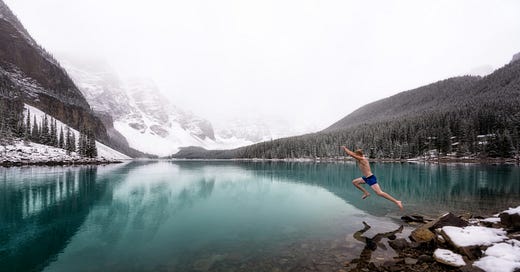Unlocking the Health Benefits of Cold Water Exposure in 90 Seconds a Day
Here's what 11 minutes a week of cold exposure did for me.
In a world where warmth and comfort often take precedence, the idea of immersing oneself in cold water might seem daunting. However, a preponderance of data suggests that embracing the cold could unlock a plethora of health benefits, both physical and mental. With that in mind, I’ve embarked on a daily ritual which is already yielding noticeable dividends at little to no financial or time cost.
Building on prior write-ups on the benefits of healthy stressors and a general overview of the merits of cold and heat exposure, this post dives into the power of cold water immersion and provides an easy, science-backed protocol that will help you get started today.
Let’s jump in!
Understanding Cold Water Exposure:
Cold water exposure, often practiced through cold showers, ice baths or winter outdoor swims, involves subjecting the body to cold temperatures. While the experience might feel shocking initially, the body's response to the cold triggers a cascade of physiological reactions that can lead to a myriad of health improvements.
Studies reveal that regular exposure to cold water packs remarkable benefits including a reduction in inflammation, improved blood circulation, lower stress levels, lower blood pressure, increased metabolism and more.
Physical Benefits:
Enhanced Circulation and Reduced Inflammation: A plunge into cold water triggers vasoconstriction – the narrowing of blood vessels – which can help improve circulation. As these blood vessels contract, they push blood towards our organs which in turn supplies the blood with more nutrients and oxygen. Once we emerge, our blood vessels dilate, creating a 'pumping' effect that enables our nutrient-rich blood to return to our tissues and help remove waste products. As a result, cold water exposure may reduce DOMS (Delayed Onset Muscle Soreness) and reduce inflammation.
Increased Metabolism: Cold water exposure can activate brown adipose tissue, which plays a pivotal role in burning calories to generate heat. Brown fat typically activates at colder temperatures, usually right before we start shivering. And although cold exposure is no substitute for physical activity and a clean diet, it can accelerate our metabolic activity and fat burning capabilities.
Boosted Immunity: Some studies even suggest that regular exposure to the cold can stimulate the production of white blood cells, strengthening the immune system's ability to fend off infections. Did you know that in some countries, parents have their infant children sleep outdoors in the dead of winter due to the purported health benefits of doing so? Can you imagine just how quickly social services would be at your doorstep if you did so here in the U.S?!
Mental and Emotional Well-being:
Mood Elevation: Cold water exposure triggers the release of endorphins, neurotransmitters known for their mood-boosting properties. If you haven’t yet experienced cold water immersion for yourself, you’ll find that most individuals (author included) report feeling invigorated and uplifted after a cold water plunge, not just in the immediate minutes following but even hours later.
Stress Reduction: The shock of cold water can act as a form of stressor, prompting the body to adapt and become more resilient to stress over time. Cold water immersion has been linked to decreased levels of cortisol, the body's primary stress hormone.
Increased Mental Alertness: Cold water exposure can jolt the body awake, sharpening mental focus and increasing alertness. Starting the day with a cold shower truly enhances cognitive function and productivity.
Protocol for Cold Water Exposure:
While the idea of plunging into icy water might seem daunting, starting slow and gradually increasing exposure can help the body adapt more comfortably. Here's a general protocol to follow:
Time of Day: Temperature and wakefulness are closely linked. Heat is the antithesis to achieving quality sleep, so it’s best to time your cold water exposure to first thing in the morning. Your body will heat itself up after cold exposure, whereas it will cool itself down after being exposed to heat (think of how chilled you feel after emerging from a sauna into regular room temperature).
Temperature: Temperature and time are also linked. We can expose ourselves to colder water for shorter periods of time and last longer in less cold temperatures. I haven’t found a well-documented sliding scale of temperature versus time but generally targeting a temperature that is uncomfortable and makes you want to get out, but allows you to safely stay exposed for several minutes is key.
Duration: Start with short exposures, begin around 15 - 30 seconds, gradually increasing to a minute or longer. Aiming for 2 - 3 minutes in a single session can yield significant benefits.
Frequency: Incorporate cold water exposure into your daily routine, aiming for 10 - 15 minutes per week of combined cold exposure (not in a single session). With that total weekly goal in mind, you could target 90 seconds every day or go for 3 - 5 weekly sessions of 2 - 3 minutes each. Contrary to popular belief, you don’t want to desensitize the body by getting so comfortable in the cold that you can last for 10 - 15 minutes in a single session. That undoes the benefit. Remember, discomfort is the goal.
Summary: That’s it. Do it in the morning, in a cold shower or ice bath that allows you to feel genuinely uncomfortable but not so uncomfortable that you can’t persist. Start small, working your way up to a minute or more. And aim for a combined 10 - 15 minutes per week.
In the realm of holistic wellness, the therapeutic potential of cold water exposure continues to captivate my attention and that of leading researchers. From invigorating the spirit to promoting cardiovascular and metabolic health, the benefits of embracing the cold are indeed multifaceted. Safely embrace the chill and embark on a journey towards enhanced vitality and well-being.
And once you do, I’d love to hear from you on your experience.




